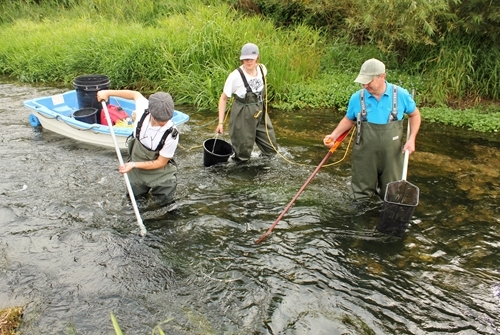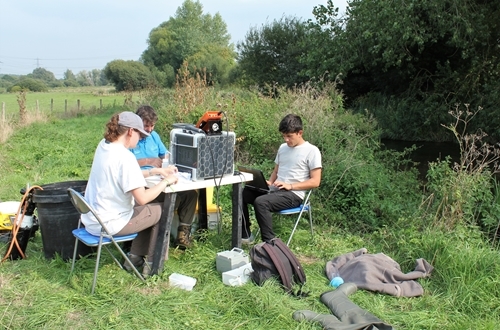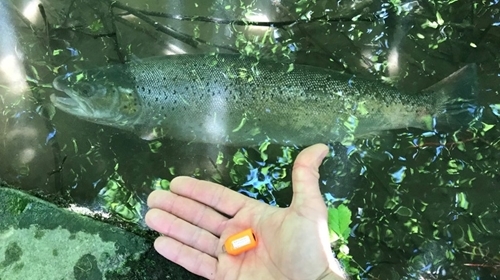By Dr Jennifer Brewin - GWCT Writer and Research Specialist

This is an important time of year for fish scientists. For those who work on salmon and trout, at least. During these few weeks, they get out into the river and begin to get an idea of how successful the last breeding season may have been. They catch young salmon and trout, measure them, weigh them, take a DNA sample and tag them. This may sound fairly straightforward, but it actually takes a lot of work. Especially when the aim is to tag one thousand fish per day!
I went to the GWCT’s fisheries research lab last week, and joined the scientists on one of their tagging days. We set off early and went in two teams to try and tackle 12 different stretches of the river that day. On each stretch, at least three (and ideally four) people get into the river in waders, pulling a boat with a generator on it. The generator is attached to an instrument that looks like a large metal detector (called an anode), which transmits a small electric current into the water immediately around it. This draws the fish in the locality towards the anode, and when they get closer it momentarily stuns them, so that they can be collected in a net and transfer to a bucket.
These fish are then taken up to a processing station that is set up on the bank. Here, we have one scientist at the computer entering data and another who measures the length and weight of each healthy fish, collects a few scales and the fish is tagged with a small device which stays with the fish for life and can be detected whenever it passes a suitable sensor. A third member of the team stores and labels the scale samples, which are used to identify the age of the fish (by using growth rings, like a tree) and are sent off for DNA analysis. The fish were very gently anaesthetised for this procedure, the whole of which takes around 20 seconds, and they recover quickly before being released back to the stretch of river they were caught in. Throughout, care is taken to have clean river water of the same temperature as the river in the buckets, with oxygen bubblers running to make sure the fish are well looked after.

We studied various different sections of the river Frome, each section of around 100m called a “reach”. In most of these, the team passed through once and collected all they could, to tag a proportion of the fish that were there and study these as representatives of the whole population. They likely manage to tag around 10% of all the fish that are found in the river, by visiting on one day and catching all they can in one pass. However, on some particular reaches they aim to count the whole population. The same reach is fished three times consecutively, and each time the scientists hope to catch less than half of the number they found the previous pass. This thorough and standardised approach, being carried out each year, gives a good idea of the actual number of fish there are in the river at that time, rather than catching the representative sample to monitor which is the aim for the other areas.
Fortunately for me, the day I went was fairly warm, and got progressively sunnier. However, the fact that teams of scientists and volunteers go out for up to 12 hours a day, every day for several weeks, demonstrates the dedication that they show to their work. It must be exhausting, and yet the team, who had been doing this for many days in a row already, were cheerful and friendly. The information they are collecting is very important to understand the declining populations of salmon and trout, and develop ways of helping them. I am looking forward to going back in the spring to watch those fish we tagged making their way out to the ocean for the next stage of their life, unwittingly providing us with critical information as they pass, and even more importantly, we’ll be looking for what proportion of them return to the Frome as adults to spawn again.
GWCT Sea Trout Appeal

Donate now >
Our sea trout are in serious trouble with stocks at historic lows. Research shows that 80% of young sea trout leaving the river will not return as adults. Please donate so we can buy and fit tracking tags to find out what is happening to them at sea.